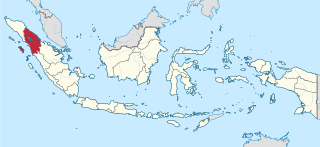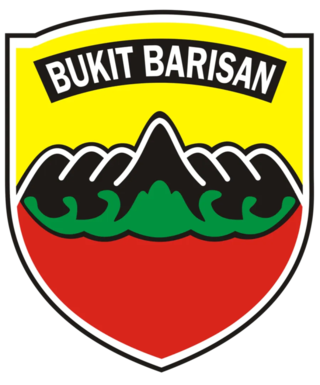
Riau is a province of Indonesia. It is located on the central eastern coast of the island of Sumatra, and extends from the eastern slopes of the Barisan Mountains to the Malacca Strait, including several large islands situated within the Strait. The province shares land borders with North Sumatra to the northwest, West Sumatra to the west, and Jambi to the south, and a maritime border with the Riau Islands and the country of Malaysia to the east. It is the second-largest province in the island of Sumatra after South Sumatra, and is slightly larger than the nation of Jordan. According to the 2020 census, Riau had a population of 6,394,087 across a land area of 89,935.90 km²; the official estimate of population as of mid-2023 was 6,642,874. The province comprises ten regencies and two cities, with Pekanbaru serving as the capital and largest city.

West Sumatra is a province of Indonesia. It is on the west coast of the island of Sumatra and includes the Mentawai Islands off that coast. West Sumatra borders the Indian Ocean to the west, as well as the provinces of North Sumatra to the north, Riau to the northeast, Jambi to the southeast, and Bengkulu to the south. The province has an area of 42,119.54 km2 (16,262.45 sq mi), or about the same size as Switzerland, with a population of 5,534,472 at the 2020 census. The official estimate at mid 2023 was 5,757,210. The province is subdivided into twelve regencies and seven cities. It has relatively more cities than other provinces outside Java, although several of them are relatively low in population compared with cities elsewhere in Indonesia. Padang is the province's capital and largest city.

North Sumatra, also called North Sumatra Province, is a province of Indonesia located in the northern part of the island of Sumatra, just south of Aceh. Its capital and largest city is Medan on the east coast of the island. It is bordered by Aceh on the northwest and Riau and West Sumatra on the southeast, by coastlines located on the Indian Ocean to the west, and by the Strait of Malacca to the east.

Padang is the capital and largest city of the Indonesian province of West Sumatra. It had a population of 833,562 at the 2010 Census and 909,040 at the 2020 Census; the official estimate as at mid 2023 was 942,938 - comprising 473,089 males and 469,849 females. It is the 16th most populous city in Indonesia and the most populous city on the west coast of Sumatra. The Padang metropolitan area is the third most populous metropolitan area in Sumatra with a population of over 1.7 million. Padang is widely known for its Minangkabau culture, cuisine, and sunset beaches.

Pagaruyung, also known as Pagarruyung, Pagar Ruyung and Malayapura or Malayupura, was a kingdom that once stood in the island of Sumatra and the seat of the Minangkabau kings of Western Sumatra. Modern Pagaruyung is a village in Tanjung Emas subdistrict, Tanah Datar regency, located near the town of Batusangkar, Indonesia.

Telephone numbers in Indonesia have different systems for land lines and mobile phones: land lines use area codes, while mobile phones do not.

The Indonesian island of Sumatra is the sixth largest island in the world. The rich ethnic diversity and historical heritage in Sumatra is reflected in the range of architectural styles in the island. The vernacular style is the native Sumatran ethnic groups architecture of dwellings, while the Hindu-Buddhist architecture reflected through the cultural historical heritage of candis built in Sumatra. The third wave is Islamic architecture adopted in mosques and palace in Sumatra, especially in Aceh, North Sumatra, and Malay cultural sphere in the island.

The mayor of Padang is an elected politician who is accountable for the strategic government of Padang, one of the provincial capitals in Indonesia. The position was first held by W.M. Ouwerkerk whe the role was created in 1928 by the Dutch colonial government, while under government of Indonesia it was first held by Abubakar Jaar in 1945, after Indonesian independence.

Military Regional Command I/Bukit Barisan is an Indonesian Army Regional Military Command that covers the Sumatran provinces of North Sumatra, West Sumatra, Riau and Riau Islands. The command takes its name from the Barisan Mountains.

Dr. Abubakar Jaar was a civil servant and lawyer for the Dutch East Indies. After the independence of Indonesia, he was mayor of Padang and resident of North Sumatra replacing Luat Siregar and resident of West Sumatra.

Said Rasjad served as acting mayor of Padang, bupati of Agam, and regent of Padang Pariaman.
This is a list of emblems or coat of arms used in Indonesia. Indonesia is divided into 38 provinces, and each province is divided into regencies (kabupaten) and cities (kota). There are 416 regencies and 98 cities. Each province, regency, and city has its own emblem.

Eny Karim, also spelled as Eni Karim, was an Indonesian politician and civil servant from West Sumatra who served as Minister of Agriculture under the Second Ali Sastroamidjojo Cabinet, and briefly as governor of North Sumatra in 1963.

Minangkabau culture is the culture of the Minangkabau ethnic group in Indonesia, part of the Indonesian culture. This culture is one of the two major cultures in the Indonesian archipelago which is very prominent and influential.

Colonel Ahmed Husein was an Indonesian independence fighter and military leader of the PRRI. Forming the Revolutionary Government of the Republic of Indonesia (PRRI) 15, 1958, in Padang under the leadership of Syafruddin Prawiranegara.

Inderapura, also known as Ujung Pagaruyung, was a kingdom located in the Pesisir Selatan Regency, present-day West Sumatra, bordering Bengkulu Province and Jambi. Officially, the kingdom was a vassal of the Pagaruyung Kingdom, although in practice it was independent and free to manage its internal and external affairs. The kingdom in its heyday covered the west coast of Sumatra from Padang in the north to Sungai Hurai in the south. Inderapura's most important products were pepper and gold.















